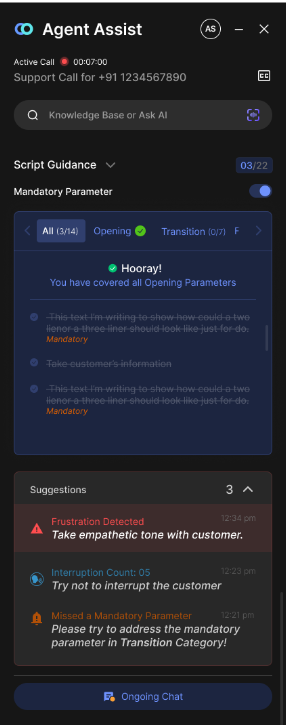In India’s insurance market, one of the most powerful levers sits quietly beneath the surface: language. With the domestic industry set to grow at over 7% annually through 2028, well above global averages, how insurers speak to customers matters more than ever.
This blog explores how regional sales teams can move beyond generic English-only messaging to conversations rooted in local phrasing, dialect comfort, and familiar tones.
You’ll see how mixed-language approaches like Hinglish drive engagement, how native-language analytics uncover hidden trust signals, and how subtle shifts in follow-ups and script design actually lift show-rates.
By reading on, you’ll learn practical strategies for deploying a multilingual AI voicebot for insurers that speaks the market’s language, not just in words, but in timing, tone, and cultural context.
Start boosting show-rates with language-smart conversations today.
Multilingual AI Voicebot for Insurers: A Language Strategy That Works
In a country as linguistically diverse as India, language isn’t a nice-to-have; it’s a conversion lever. A recent study found that 57% of internet users prefer using Indian languages over English.
For regional sales teams in insurance, this means that generic, English‑only messaging loses reach fast.
When your customers prefer local‑language communication, deploying a multilingual AI voicebot for insurers becomes critical, not just for inclusivity, but for business outcomes.
1. Conversational AI for Insurance That Aligns with Buyer Behaviour
In India’s multi‑lingual market, the gap between what customers want and how they’re addressed is big. For example, insurers that deliver a truly localised experience see better engagement, when customers feel conversations are “in my words”, trust increases.
With the introduction of a multilingual AI voicebot for insurers, sales teams can align language strategy with buyer behaviour, not just in words, but in timing, tone, and context. That means:
2. What Regional Buyers Actually Say: Insights from Sales Conversations
When you listen to hundreds of regional calls, three patterns keep repeating: the phrasing is informal, the question is trust-based, and the decision hinges on clarity in their own dialect. Sales teams often overlook these signals, leading to lower show-rates.
For example, in Tier 2 and Tier 3 markets, many buyers say things like:
“Agent ne thodi der baad boliya, toh main wapas busy ho gaya.”
“Policy ki baat hui, par samajh nahin paa raha tha uss English document ko.”
Underlying both is the same friction: the language didn’t match their pace or phrasing.
One recent study reveals that linguistic barriers make an estimated 10 %–25 % of insurance records unreliable. That means one in every ten to four prospects could drop off simply because the language didn’t align.
From these insights, we can draw three practical observations.
- Relatable opening lines matter. A simple “Kaise ho? Aapki chikitsa policy pe baat karein?” beats “Good afternoon, we’d like to discuss your health policy options.”
- Clarification in local phrasing wins trust. Buyers often ask “Yeh premium ka matlab kya hai?” or “Claim ke liye hum kya karenge?”, not the formal “What is the policy premium?”
- Timing and tone reflect comfort. A voicebot or agent using the local language and dialect keeps the call in the prospect’s comfort zone, rather than making them switch mentally.
These behaviours reflect what regional customers expect: a conversation, not a lecture; a voice they recognise, not one they must translate in their head.
For regional sales teams, the insight is clear: adjusting language isn’t optional, it’s foundational. A multilingual voice agent that mirrors how buyers actually talk won’t just reduce friction, it will boost show-rates and deepen engagement by speaking the buyer’s native rhythm.
Use buyer-first language cues to lift engagement across regions.
How a Multilingual Voice Agent Increases Show-Rates
Many regional sales teams treat show‑rates as a scheduling issue; in truth, they’re a language and timing problem. Research shows that follow‑up engagement alone can boost response rates by up to 42 %.
Meanwhile, reminder systems with behavioural nudges reduce no‑show rates significantly across industries. For insurers, this means a regular reminder in business English isn’t enough; what matters is the right message, in the right language, at the right time.
1. Using Hinglish Where It Matters: Policy Reminders & Follow-ups
Hinglish becomes most effective during high‑impact touchpoints like reminders, confirmations, and follow‑ups, moments where buyers often hesitate or forget to engage.
These short exchanges determine whether a customer shows up or drifts away. The IAMAI–Kantar Internet in India 2024 report notes that 57% of urban internet users prefer consuming content in regional or Indic languages, underscoring a clear preference for familiar, mixed‑language communication.
When policy reminders are delivered in Hinglish instead of formal English, they feel lighter, more familiar, and easier to respond to. For instance, a simple “Kal policy baat‑cheet ke liye free ho?” outperforms the more formal “This is a reminder for your scheduled policy discussion.” One sounds conversational; the other sounds like a corporate notification.
Convin’s insurance call intelligence also shows that buyers acknowledge Hinglish reminders more consistently in Tier 2 and Tier 3 markets. The tone feels less transactional and more human, which lowers friction and encourages timely action.
Hinglish works because it mirrors everyday speech. When follow‑ups sound natural, buyers engage freely, lifting show‑rates without adding pressure.
2. Real-World Phrasing That Reduces Missed Appointments
Missed appointments in insurance rarely happen because buyers aren’t interested—they happen because instructions feel heavy or unclear. A multilingual AI voicebot for insurers reduces this friction by using phrasing that matches how buyers naturally make decisions.
A common hesitation we hear in recorded calls is: “Kitna time lagega?” This tells us the buyer is unsure of the effort required. A phrase like “Bas 10 minute ki baat hai, aapka benefit samjha dunga” reduces perceived effort and increases commitment.
Behavioural economics backs this: people act more when the effort feels small and the benefit is immediate, a principle validated by the Fogg Behaviour Model (Stanford University).
Convin’s analysis shows that short, benefit-first phrasing leads to smoother confirmations and fewer no-shows. When buyers are reassured in simple, local phrasing, the path to action becomes lighter and more predictable.
Real-world phrasing minimises cognitive load. When instructions feel simple and aligned with natural speech, appointment adherence rises.
Boost show-rates with native-language phrasing that drives action.
This blog is just the start.
Unlock the power of Convin’s AI with a live demo.

Why Language Strategy is Core to Insurance Sales
In India’s insurance market, language is far more than a communication detail; it’s a trust lever. According to a recent industry insight, misunderstandings arising from language barriers can make 10‑25% of insurance records unreliable, undermining clarity and increasing risk.
For regional sales teams, that means a robust language strategy isn’t optional; it influences every policy discussion, advisor call, and renewal prompt. Below, you’ll explore how regional personalisation and multilingual conversations build real business value.
1. Regional Personalisation Beats Generic Scripts
Regional buyers don’t just prefer familiar phrasing; they expect it. Every market has its own rhythm, dialect cues, and conversational shortcuts. When insurers rely on generic scripts, buyers sense the disconnect immediately, leading to lower engagement and higher drop-offs.
A study by CSA Research found that 76% of consumers prefer buying from brands that communicate in their own language, reinforcing that personalisation isn’t optional, it's fundamental.
In insurance specifically, personalisation goes beyond language; it’s about cultural tone. For example, buyers in northern regions respond better to relational cues (“Aap batayein, main madad karta hoon”), while southern markets tend to value clarity-first structure.
A multilingual voice agent can adapt this nuance dynamically, offering not just translation, but contextual alignment, something a static script can’t achieve.
Convin’s conversation intelligence frequently uncovers region-specific phrasing that leads to higher confirmations and fewer objections. Because these insights come from real calls, not assumptions, sales teams gain a living library of what actually resonates in each geography.
Regional personalisation doesn’t just make conversations smoother; it makes them effective. When outreach reflects local speech patterns, buyers feel understood, and show rates rise accordingly.
2. Compliance and Trust Through Multilingual Conversations
Compliance in insurance hinges on clarity, and clarity only exists when the customer fully understands the information in their preferred language. Miscommunication increases the risk of missed disclosures, policy misunderstandings, and downstream disputes.
A Deloitte report states that 32% of insurance complaints stem from unclear or incomplete communication, much of it tied to language or comprehension gaps.
A multilingual AI voicebot for insurers helps close this gap by standardising compliant phrasing across languages while preserving natural speech.
Instead of agents improvising explanations, the multilingual voice agent ensures disclosures, reminders, and instructions remain accurate, no matter which language or dialect is used. This consistency reduces risk and builds customer trust during every interaction.
Convin strengthens this further by transcribing conversations in native languages, flagging missing disclosures, and identifying trust-breaking phrases.
The system highlights where customers appeared confused or asked for clarification, enabling teams to refine scripts and maintain compliance without losing conversational warmth.
Multilingual communication isn’t just a CX asset; it’s a compliance safeguard. When customers understand every detail, trust grows and complaint risk drops.
Strengthen trust and compliance with clear multilingual conversations.
How Convin Approaches Multilingual AI Voicebot for Insurers
In the fast‑paced world of regional insurance sales, a generic tech stack won’t cut it. You need a platform built for multilingual intelligence, live agent support, and deep analytics, one that speaks Hinglish and local dialects as fluently as it handles English.
That’s where the multilingual AI voicebot for insurers from Convin enters the equation. It’s not about novelty; it’s about features that directly tie to show‑rates, conversions, compliance, and regional sales outcomes. Below are the critical aspects that make it work.

1. Real-Time Agent Assist with Local Context
Regional insurance conversations often hinge on micro-cues: the way a buyer pauses, asks a half-formed question, or repeats a word in their dialect. These cues indicate confusion or hesitation, but most agents miss them because they’re juggling scripts, systems, compliance prompts, and customer emotions all at once.
Real-time Agent Assist closes this gap by helping agents respond in the right language, with the right context, the moment it’s needed.
Industry research shows that agents spend up to 25% of call time searching for information or phrasing needed to respond effectively. This delay reduces clarity and weakens the buyer’s confidence in the call.
When a powerful multilingual voice agent assists in real-time, surfacing Hinglish cues, local phrasing, benefit-first explanations, or compliance prompts, agents can stay fully present in the conversation. Buyers, in turn, feel heard rather than processed.
Convin’s real-time Agent Assist learns from thousands of insurance conversations across regions, identifying the precise language patterns that reduce objections and increase confirmations.
During live calls, it nudges agents with context-specific suggestions like simplified renewal explanations, region-friendly vocabulary, or clarity-first phrasing. This doesn’t replace agent skill; it amplifies it by ensuring every response fits the buyer’s linguistic comfort zone.
The result is stronger engagement: conversations flow more naturally, objections reduce, and complex policy terms become easier for buyers to absorb. When agents sound confident and relatable, buyers stay on the call longer, and show rates rise as a direct outcome.
Real-time Agent Assist bridges the gap between agent expertise and buyer expectations. With local context built into every cue, agents deliver clearer, faster, and more relatable conversations that move customers toward action.
2. Voice of Customer and Sales Analytics in Native Languages
Understanding what customers truly mean, and not just what they say, has always been a challenge in insurance. This gap widens in regional markets, where buyers switch between Hindi, Hinglish, and local dialects within the same sentence.
Traditional analytics tools miss these nuances, leading to incomplete insights. That’s why capturing Voice of Customer data in native languages is essential for insurers who want to understand intent, trust signals, hesitations, and decision triggers at scale.
A Forrester study shows that insurers using advanced speech and text analytics improve customer understanding by up to 40%, thanks to deeper insight into emotional cues and intent markers.
But these systems only work when they understand the customer’s actual language, not just English. Dialect shifts, regional idioms, and emotional markers often get lost in translation, leading to gaps in analysis.
When analytics operate in native languages, patterns emerge more clearly: which phrases stop a buyer from renewing, which words increase trust during claims conversations, and which policy explanations consistently confuse.
Convin strengthens this capability by analysing conversations in Hindi, Hinglish, Tamil, Bengali, Marathi, and other Indian languages, without forcing conversations into English transcripts.
This allows insurers to see region-specific friction points, track sentiment in native expressions, and detect vocabulary that drives higher show-rates. Over time, insurers build a richer view of buyer behaviour, not just at a national level, but hyper-locally.
Native-language analytics makes conversational AI for insurance more accurate, more aligned to real customer behaviour, and more actionable for sales teams.
Instead of broad assumptions, leaders can make region-specific improvements that directly impact conversion, trust, and retention.
When analytics listen to the language customers speak, insurers gain clearer signals, stronger intent understanding, and smarter guidance for sales teams, unlocking measurable gains across the funnel.
Unlock deeper customer insights with native-language sales analytics.
Regional Sales Teams Win with a Practical Voice Strategy
In India’s insurance market, language isn’t decoration; it’s the structure that holds every conversation together. When buyers hear policy details in words they use daily, their willingness to engage rises, and misinterpretations fall.
Regional teams see this shift first: clearer calls, fewer doubts, and steadier show-rates. A multilingual AI voicebot for insurers fits naturally into this reality, helping teams stay aligned with how customers actually talk.
As regional preferences grow stronger, the gap between scripted communication and lived language becomes more visible. Teams that adapt their phrasing earn trust quickly and move prospects through the funnel with less resistance.
Convin supports this progression by offering one platform that mirrors real regional language behaviour across reminders, follow-ups, disclosures, and analytics, without forcing teams to change how they work.
The insurers who advance next will be those who treat language as strategy, not afterthought. When every call sounds familiar and every explanation makes sense the first time, buyers stay with you. Convin helps make this consistency scalable, so regional teams deliver clarity at volume.
Ready to improve show-rates with conversations that feel natural to your market? Book your demo today!
FAQ
1. How does a multilingual AI voicebot for insurers improve show-rates?
It improves show-rates by using Hinglish and regional phrasing that buyers understand instantly. Familiar language reduces hesitation, clarifies intent, and increases callback and confirmation rates across Tier 2 and Tier 3 markets.
2. Why is regional phrasing more effective than standard English scripts?
Regional phrasing reflects how customers actually speak and process information. When policy reminders, follow-ups, and disclosures match local speech patterns, buyers feel more comfortable and respond faster, leading to higher engagement and fewer drop-offs.
3. What makes conversational AI for insurance different in India’s market?
Indian buyers switch between multiple languages in a single sentence. Conversational AI for insurance adapts to these shifts, capturing intent, sentiment, and trust signals more accurately than English-only systems, especially during policy explanations and renewal calls.
4. How does Convin support regional sales teams with multilingual conversations?
Convin provides one platform with a multilingual AI voicebot for insurers, real-time agent assist, and native-language analytics. It helps teams deliver clearer conversations, maintain compliance, and strengthen trust through regionally aligned phrasing.








.avif)